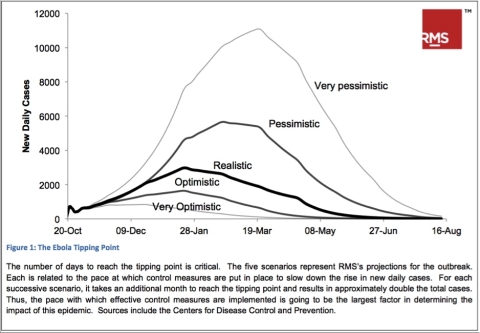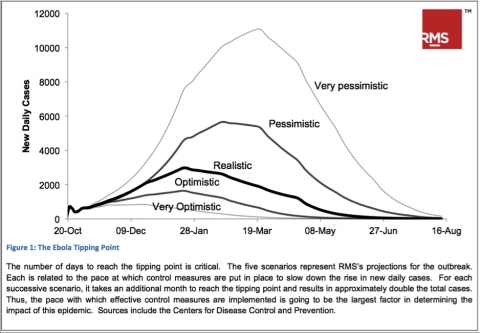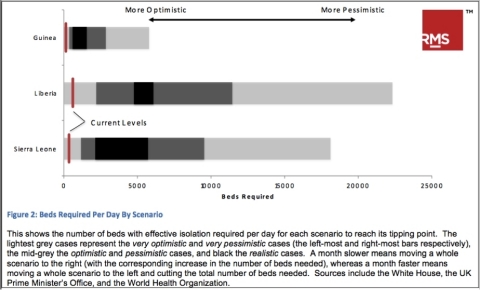NEWARK, Calif.--(BUSINESS WIRE)--According to a new report by RMS, the world’s leading catastrophe risk management firm, the Ebola virus disease outbreak in West Africa has the potential to be the most deadly infectious disease event since the 1918 flu pandemic.
The current outbreak will continue to worsen while the deployment of resources is ramped up to meet the caseload. According to RMS modeling, until a tipping point is reached where the number of new daily cases declines rather than increases, the severity of the outbreak will continue to multiply, with the total number of new cases approximately doubling each month.
“Controlling the spread of this Ebola outbreak is more a question of logistics than virology,” said Dominic Smith, pandemic risk expert and senior manager of Life Risks at RMS. “The fight against the Ebola epidemic is a race against a moving target; more resources are required as the number of cases increases.”
RMS modeling suggests that, based on current response efforts, the tipping point will not be reached until January 2015. Modeling further reveals a 55 percent chance that by the end of November, at least 1,000 new cases of Ebola will develop daily, and as many as 1,400 per day in a worst-case scenario. There have been more than 9,000 cases reported in total to date.
Adding to the devastation of the Ebola outbreak, overwhelmed medical systems in West Africa have less resources to respond to other diseases and the mortality rate of malaria and yellow fever is on the rise. Malaria deaths are likely to continue rising as the seasonal height of malaria transmission is reached next month.
RMS modeled the future paths of cases and deaths from the Ebola virus in Sierra Leone, Guinea and Liberia, which were combined with a probabilistic assessment of various international medical and military response scenarios to estimate the timing of the tipping point where cases are controlled such that the disease tapers off.
Reaching the Tipping Point
If effective resources are deployed at a rate that outstrips the pace of increase in new cases, a tipping point can be reached where the number of new daily cases reaches a maximum, allowing response measures to kick in and prevent new infections at a rate that causes the epidemic to subside.
“The way to stop this outbreak is simple in principle and has been demonstrated in Nigeria and in specific cities in the affected region: reduce contacts with infected people by more than half,” said Smith. “The scale and pace of the international response will define how long it takes to reach the tipping point.”
The U.S. Centers for Disease Control and Prevention (CDC) estimates that, even in the absence of treatments and vaccines, the epidemic would be brought under control and eventually come to an end if approximately 70 to 75 percent of cases are in medical care or treatment units, or in environments where there is a reduced risk of disease transmission.
In a realistic scenario based on current response efforts, RMS analysis projects the tipping point will be reached at the end of January 2015, with the outbreak subsiding by June 2015.
Modeling the West African Ebola Outbreak
When modeling a disease, RMS first looks at the reported virulence and the transmissibility of the pathogen responsible for causing Ebola. This virus is extremely deadly, with an estimated case fatality rate of 69 to 73 percent. This range of estimates for transmissibility, as measured by R0, is between 1.5 and 2.2, which means on average an infected individual will transmit the virus to approximately two other people in a susceptible population.
RMS then takes into account mitigating criteria, including medical and non-medical interventions. In its modeling, RMS evaluated the current response resources in place in impacted countries, further resources already pledged and a range of estimates of potential additional resources that will be deployed. For each country, RMS used these factors to formulate five scenarios, ranging from very optimistic to very pessimistic, and their associated probabilities.
The number of beds for Ebola treatment currently in use is far below what is needed to reverse the outbreak in any of the three effected countries. To reach the tipping point sooner, faster ramp up of mitigating efforts is essential, but subsequently, fewer total beds and resources in general will be required.
For example, in order to reach the tipping point in Sierra Leone, the current number of beds in use needs to be approximately tripled by the end of November to halt the outbreak with the smallest total number of cases and at the lowest overall cost. If that fails, the number will need to increase to six times today’s number by the end of December to halt the outbreak.
A large degree of reliance will be placed on beds being rolled out in Ebola treatment centers (ETCs), which cost $5.7 million to set up and run a fifty-bed center for one month. Ebola community care units (ECUs) staffed by rapidly trained non-experts rather than medical workers are being set up in some areas, but there is larger uncertainty surrounding their effectiveness.
Treatments might help reduce the case fatality rate, but are very unlikely to have a significant role in halting the spread of the Ebola epidemic. An Ebola vaccine might be available in time to shorten the epidemic, but will not be produced in sufficient quantities to have an active role in halting the spread of the epidemic in the next few months.
Ebola Outside of West Africa
RMS does not expect this outbreak of Ebola to become a significant mortality threat in other parts of the world. It is possible that it could spread to neighboring countries in West Africa. This risk can be reduced by appropriate screening of people leaving the impacted region and could be contained with rapid implementation of effective control measures.
In the situation where there are potentially 10,000 new cases per week in West Africa, there will be more cases exported into other countries. This is possible via two routes:
- Foreign workers combating the spread of the virus are likely to be repatriated to their home countries. Currently the United States, United Kingdom, France and Cuba have delivered personnel in significant numbers. RMS does not consider this to be a probable source of escalation as such cases will be monitored and isolated by the public health systems already in place in those countries.
- Infected people travelling to other regions unchecked could transmit Ebola outside of West Africa. However, the capability of most countries to trace contacts is higher than in Liberia and Sierra Leone, and stronger travel control measures could be implemented if case numbers exceeded a prudent limit.
RMS will be updating the model with new numbers every few weeks, projecting the course of the event in near real-time.
About RMS
RMS models and software help financial institutions and public agencies evaluate and manage catastrophe risks throughout the world, promoting resilient societies and a sustainable global economy.
Learn more at www.rms.com and follow us @RMS.





